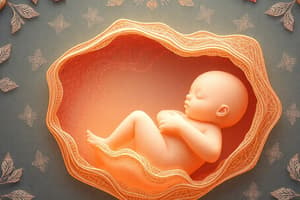Podcast
Questions and Answers
What type of placenta is characterized by many spotlike placental regions of the endometrium known as caruncles?
What type of placenta is characterized by many spotlike placental regions of the endometrium known as caruncles?
- Discoid
- Multicotyledonary (correct)
- Zonary
- Bidiscoid
What is the process of placing semen into the female's cervix or uterus called?
What is the process of placing semen into the female's cervix or uterus called?
- Fertilization
- Insemination (correct)
- Implantation
- Gestation
Which type of placenta shows an intimate interdigitating contact zone that forms a belt around the chorionic sac?
Which type of placenta shows an intimate interdigitating contact zone that forms a belt around the chorionic sac?
- Discoid
- Zonary (correct)
- Bidiscoid
- Multicotyledonary
What type of placenta is characterized by a single or double disc, and interaction is confined to a roughly circular area?
What type of placenta is characterized by a single or double disc, and interaction is confined to a roughly circular area?
What is the term for the time period during which an animal is pregnant?
What is the term for the time period during which an animal is pregnant?
What is the function of interferon τ in cattle?
What is the function of interferon τ in cattle?
What is the process by which the fertilized ovum or zygote breaks free from the surrounding membrane?
What is the process by which the fertilized ovum or zygote breaks free from the surrounding membrane?
What are the three major layers formed during embryonic development?
What are the three major layers formed during embryonic development?
What is the role of conceptus-generated estrogens in pigs?
What is the role of conceptus-generated estrogens in pigs?
What is the approximate gestation period for cattle?
What is the approximate gestation period for cattle?
When does embryonic development transition to fetal development?
When does embryonic development transition to fetal development?
What is the function of the placenta during embryonic development?
What is the function of the placenta during embryonic development?
What is the function of the embryonic/fetal membranes?
What is the function of the embryonic/fetal membranes?
Which embryonic membrane is composed of endoderm and mesoderm?
Which embryonic membrane is composed of endoderm and mesoderm?
What is the term for the fetal membrane formed by the combination of the embryonic chorion and allantois?
What is the term for the fetal membrane formed by the combination of the embryonic chorion and allantois?
In which type of placenta is there a loss of maternal epithelium and connective tissue?
In which type of placenta is there a loss of maternal epithelium and connective tissue?
What is the term for the classification of placentas based on the structure and formation of villi?
What is the term for the classification of placentas based on the structure and formation of villi?
In which species is the diffuse type of placenta found?
In which species is the diffuse type of placenta found?
Flashcards are hidden until you start studying
Study Notes
Placenta Types
- Multicotyledonary placenta: characterized by many spot-like placental regions of the endometrium known as caruncles
- Zonary placenta: shows an intimate interdigitating contact zone that forms a belt around the chorionic sac
- Discoid/bidiscoid placenta: characterized by a single (discoid) or double disc (bidiscoid) interaction confined to a roughly circular area
Pregnancy Recognition
- In cattle: trophectoderm of the conceptus releases interferon t, inhibiting prostaglandin F2α production from the uterus
- In pigs: conceptus-generated estrogens prevent prostaglandin F2 from reaching the CL (corpus luteum)
Gestation Periods
- Domestic animals:
• Cat: 65 days
• Rabbit: 31 days
• Sheep: 150 days
• Buffalo: 281-334 days
• Other animals:
- Bison: 280 days
- Cattle (different breeds): • Angus: 281 days • Brahman: 292 days • Brown Swiss: 290 days • Holstein: 279 days • Simmental: 289 days
- Dog: 62-64 days
- Deer (Mule and White-tailed): 200 days
- Donkey: 365 days
- Goat: 150 days
- Camel: 365-400 days
- Horse: 335-342 days
- Elephant: 660 days
- Llama, Alpaca: 335-365 days
- Guinea pig: 59-72 days
- Pig: 114 days
Pregnancy or Gestation
- Defined as the time during which an animal is pregnant
- Duration varies with species
- Continuum of development in utero, including: • Cell division immediately after fertilization • Fertilized ovum or zygote hatching from the zona pellucida • Differentiation with the formation of embryonic/fetal membranes and major layers (endoderm, mesoderm, and ectoderm) • Implantation, requiring shedding of zona pellucida, correct orientation of blastocyst, adhesion, and invasion of endometrium • Embryonic development with organ formation • Growth and development of the fetus
Embryonic/Fetal Membranes
- Surround or partially surround the embryo/fetus
- Comprise: • Chorion (ectoderm and mesoderm) • Amnion (ectoderm and mesoderm) • Allantois (endoderm and mesoderm) • Yolk sac (endoderm and mesoderm)
Placenta
- Site of contact between the developing embryo/fetus and the mother
- Nutrients, respiratory gases, and wastes are exchanged across the placenta
- Components: • Fetal side: chorionic plate, chorionic surface arteries, and veins connected to umbilical arteries and vein • Maternal side: maternal decidua and basal plate with maternal vessels • Middle portion: placental villi in maternal blood
Classification of Placentas
- Morphological classification: • Diffuse: over the entire surface of the uterine luminal epithelium with formation of folds/villi, e.g., horses and pigs
Studying That Suits You
Use AI to generate personalized quizzes and flashcards to suit your learning preferences.




